Diabetes is a common but serious condition in dogs, and its management is crucial to maintaining their overall health and well-being. One of the most effective ways to help manage diabetes in dogs is through a carefully planned, homemade diet. Homemade dog food for diabetic dogs provides a tailored approach that can regulate blood sugar levels, improve energy, and reduce the need for insulin in some cases. By preparing fresh meals for your diabetic dog, you can better control the quality and quantity of ingredients, ensuring that your pet gets the nutrients they need without the unnecessary additives and sugar found in many commercial pet foods.
In this guide, we’ll dive deep into the reasons why homemade dog food for diabetic dogs is a great choice, the types of ingredients that should be included, and share some delicious and nutritious recipes. We’ll also provide expert tips and important considerations when transitioning your dog to a homemade diet. By the end, you’ll have the knowledge and confidence to help manage your dog’s diabetes through food.
What Is Diabetes in Dogs?

Diabetes in dogs is a serious medical condition that affects how their bodies process food and convert it into energy. Just like in humans, diabetes occurs when the dog’s body either cannot produce enough insulin (Type 1 Diabetes) or cannot use insulin properly (Type 2 Diabetes). Insulin is a hormone produced by the pancreas that helps regulate blood sugar levels by allowing sugar (glucose) to enter cells where it can be used for energy. Without proper insulin function, glucose levels in the bloodstream can rise, leading to high blood sugar (hyperglycemia).
Types of Diabetes in Dogs
- Type 1 Diabetes: This is the most common form of diabetes in dogs. The pancreas fails to produce sufficient insulin, and the dog must rely on insulin injections to regulate blood sugar.
- Type 2 Diabetes: This type is less common in dogs but occurs when the body becomes resistant to insulin. Type 2 diabetes is usually associated with obesity and poor diet and can sometimes be managed with diet and medication alone, without the need for insulin injections.
Symptoms of Diabetes in Dogs
Recognizing the signs of diabetes early can make a huge difference in managing the condition. Common symptoms of diabetes in dogs include:
- Excessive thirst and urination: High blood sugar levels cause increased urination, which leads to dehydration and excessive thirst.
- Weight loss despite an increased appetite: While a diabetic dog may eat more, they may still lose weight because their body cannot properly convert food into energy.
- Lethargy and weakness: Lack of energy is common as the dog’s body struggles to get the energy it needs from food.
- Cloudy eyes or cataracts: High blood sugar levels can cause changes in the lens of the eye, leading to cataracts, which are common in diabetic dogs.
- Increased appetite: As the body cannot utilize the glucose from food, the dog may feel hungry more often.
How Diabetes Affects a Dog’s Metabolism
When a dog has diabetes, the regulation of glucose is compromised, affecting how the body processes food. In a healthy dog, insulin helps convert food into glucose, which is used as fuel. Without insulin, glucose builds up in the bloodstream, leading to high blood sugar levels, and the body starts using fat and muscle tissue as an alternative source of energy. This results in weight loss, muscle wasting, and the body becoming imbalanced.
By carefully managing their diet, owners can help regulate blood sugar and prevent or minimize the onset of serious complications like kidney disease, nerve damage, or cardiovascular problems that are common in dogs with poorly managed diabetes.
Homemade Dog Food Recipes for Diabetic Dogs

Now that we’ve covered the key ingredients and foods to avoid, let’s dive into some delicious and nutritious homemade dog food recipes specifically designed for diabetic dogs. These recipes are tailored to help manage blood sugar levels while providing all the necessary nutrients to keep your dog healthy and happy.
1. Chicken and Sweet Potato Stew
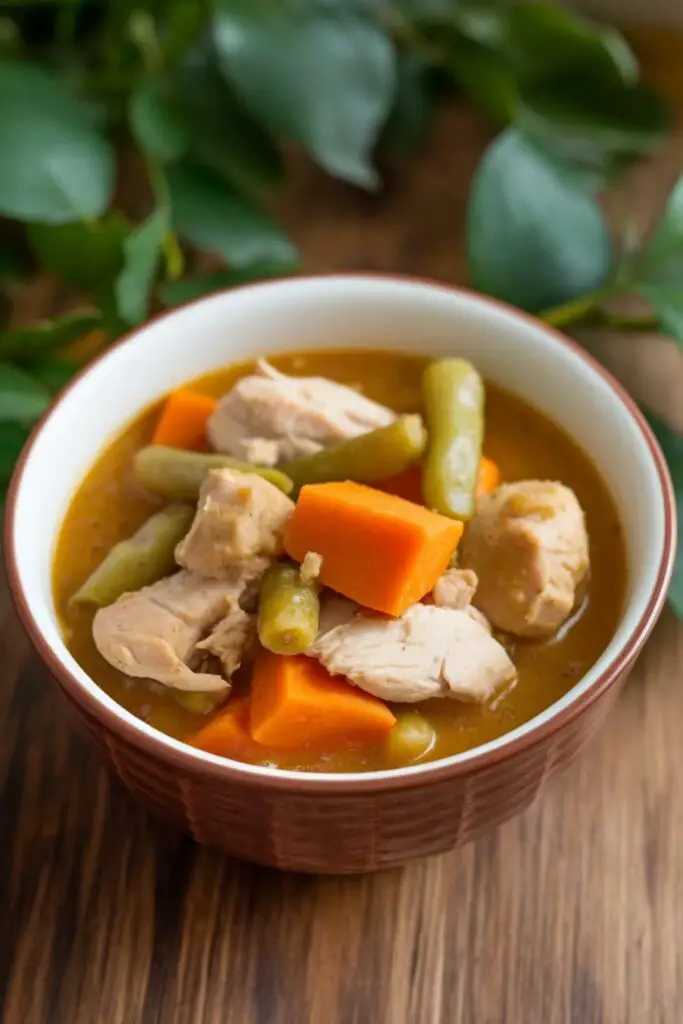
A hearty, fiber-rich meal perfect for maintaining steady energy levels in diabetic dogs.
Ingredients
- 2 boneless, skinless chicken breasts, chopped
- 1 medium sweet potato, peeled and diced
- 1/2 cup green beans, chopped
- 1/2 cup carrots, chopped
- 1 tablespoon olive oil
- 2 cups water or low-sodium chicken broth (unsalted)
Instructions
- Heat the olive oil in a large pot over medium heat.
- Add the chopped chicken and cook until browned and fully cooked, about 7-8 minutes.
- Add the sweet potatoes, green beans, and carrots to the pot.
- Pour in the water or chicken broth and bring the mixture to a boil.
- Lower the heat and simmer for about 20-25 minutes, or until the vegetables are tender.
- Allow the stew to cool before serving. Store leftovers in the fridge for up to 3 days.
Cooking Time
- Preparation: 10 minutes
- Cooking: 25 minutes
- Total: 35 minutes
Tips and Variations
- Vegetable Variations: Substitute sweet potatoes with butternut squash for a seasonal twist.
- Herb Additions: Add a sprinkle of parsley for added vitamins and a fresh flavor.
Why It’s Good for Diabetic Dogs
- Chicken: Lean protein helps regulate blood sugar and maintain muscle.
- Sweet Potatoes: A low-glycemic carbohydrate that prevents blood sugar spikes.
- Vegetables: High in fiber and low in sugar, promoting stable glucose levels.
2. Turkey and Quinoa Bowl
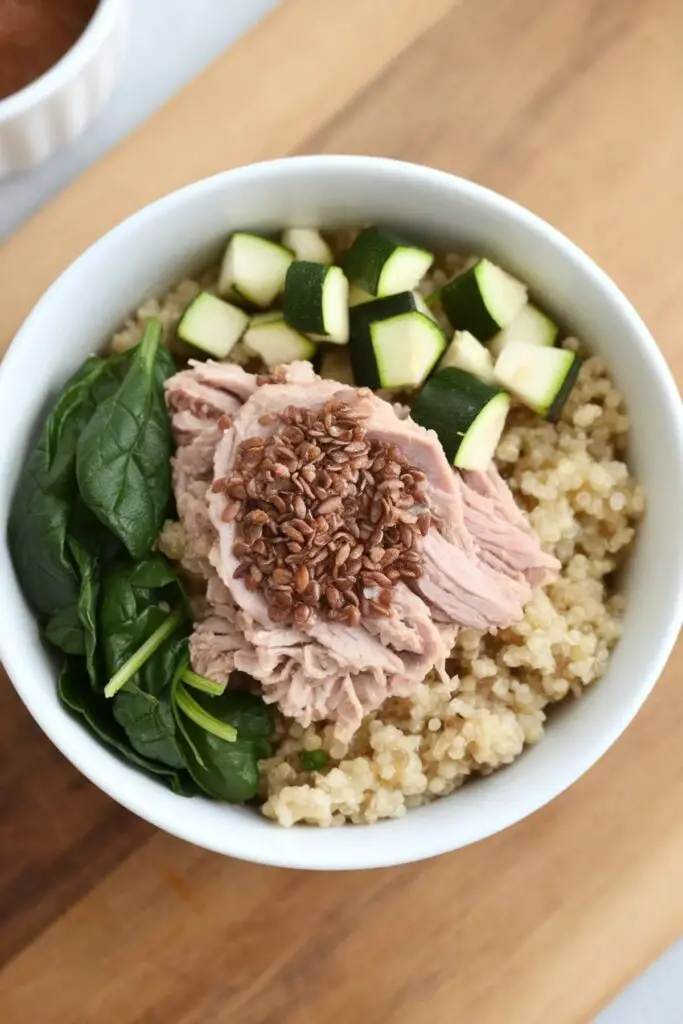
A balanced combination of lean protein, fiber, and low-glycemic carbs for a healthy meal.
Ingredients
- 1 pound ground turkey (lean)
- 1 cup quinoa
- 1/2 cup spinach, chopped
- 1/4 cup zucchini, chopped
- 1 tablespoon flaxseed (optional)
Instructions
- Cook the quinoa according to package instructions.
- In a pan, cook the ground turkey over medium heat until browned, breaking it up as it cooks.
- Add the spinach and zucchini to the pan with the turkey. Cook for 3-4 minutes until vegetables are tender.
- Combine the cooked quinoa with the turkey mixture. Stir in flaxseed (if using).
- Allow the mixture to cool before serving. Store leftovers in the fridge for up to 4 days.
Cooking Time
- Preparation: 10 minutes
- Cooking: 20 minutes
- Total: 30 minutes
Tips and Variations
- Grain-Free Option: Replace quinoa with cauliflower rice for a low-carb alternative.
- Add Extra Veggies: Include chopped bell peppers for a pop of color and added vitamins.
Why It’s Good for Diabetic Dogs
- Turkey: A lean protein that supports muscle growth and stabilizes blood sugar.
- Quinoa: Low-glycemic and high in fiber, helping regulate glucose levels.
- Spinach and Zucchini: Rich in vitamins and antioxidants to support overall health.
3. Salmon and Pumpkin Mash

A flavorful, omega-3-rich dish that supports heart health and reduces inflammation.
Ingredients
- 2 salmon fillets (fresh or canned in water, no added salt)
- 1/2 cup pumpkin puree (unsweetened)
- 1/2 cup spinach, chopped
- 1/4 cup carrots, grated
- 1 tablespoon olive oil
Instructions
- If using fresh salmon, cook it by baking, grilling, or pan-frying until fully cooked. If using canned salmon, drain and remove any bones.
- Mash the salmon in a large bowl using a fork.
- Add pumpkin puree, spinach, and grated carrots to the bowl. Mix well.
- Drizzle olive oil over the mixture and combine.
- Serve immediately or store leftovers in the fridge for up to 3 days.
Cooking Time
- Preparation: 10 minutes
- Cooking: 15 minutes
- Total: 25 minutes
Tips and Variations
- Add Crunch: Mix in a tablespoon of sunflower seeds for texture and added nutrients.
- Freeze for Later: Divide into portions and freeze for a convenient meal option.
Why It’s Good for Diabetic Dogs
- Salmon: High-quality protein and omega-3s support a healthy coat and reduce inflammation.
- Pumpkin: Low-glycemic and fiber-rich, aiding digestion and stabilizing blood sugar.
- Spinach and Carrots: Packed with vitamins and minerals for immune support.
4. Beef and Barley Medley
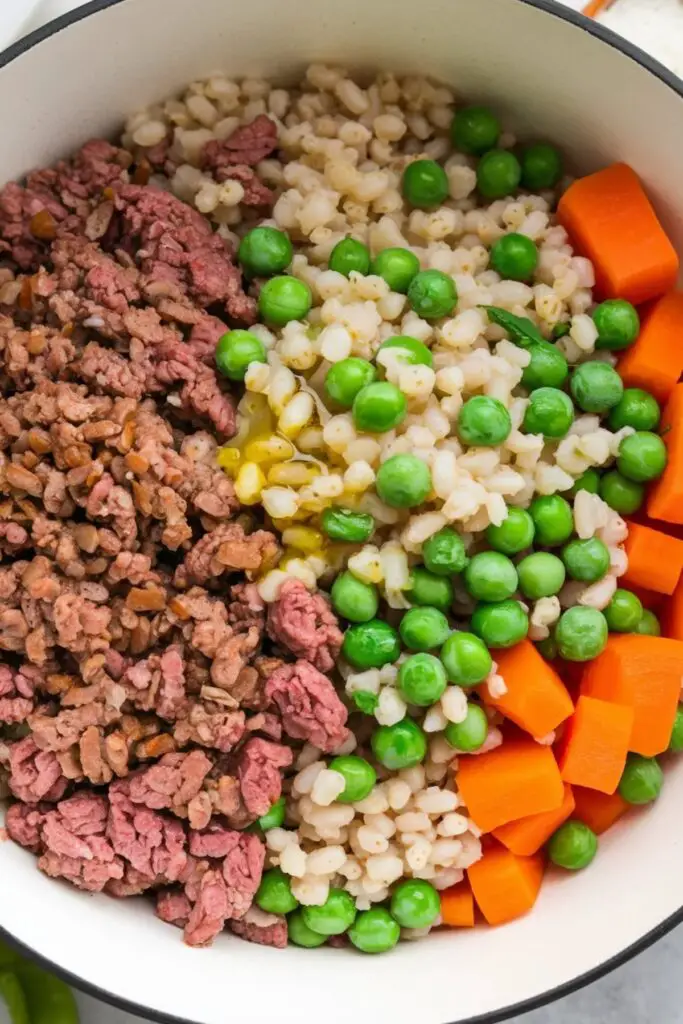
A hearty and fiber-rich recipe to keep your diabetic dog satisfied and healthy.
Ingredients
- 1 pound lean ground beef
- 1/2 cup barley
- 1/2 cup peas (fresh or frozen)
- 1/2 cup carrots, chopped
- 1 tablespoon olive oil
Instructions
- Cook the barley according to package instructions.
- In a large pan, cook the ground beef over medium heat until fully cooked and browned.
- Add peas and carrots to the pan. Cook for 3-4 minutes until vegetables are tender.
- Stir in the cooked barley and drizzle with olive oil.
- Allow the mixture to cool before serving. Store leftovers in the fridge for up to 4 days.
Cooking Time
- Preparation: 10 minutes
- Cooking: 20 minutes
- Total: 30 minutes
Tips and Variations
- Boost Flavor: Add a pinch of turmeric for anti-inflammatory benefits.
- Swap Grains: Replace barley with brown rice or quinoa for variety.
Why It’s Good for Diabetic Dogs
- Beef: Provides protein and essential nutrients while managing fat content.
- Barley: A low-glycemic, high-fiber grain that stabilizes blood sugar.
- Vegetables: Add fiber, vitamins, and minerals to support overall health.
Why Is Diet So Important for Diabetic Dogs?
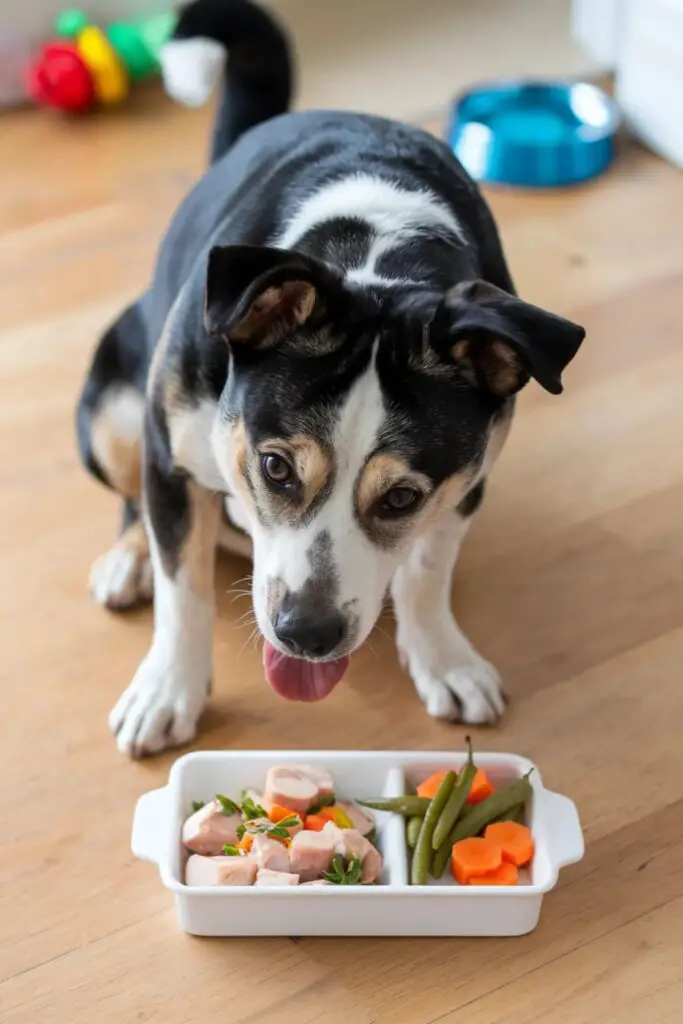
Diet plays a crucial role in managing diabetes in dogs. Since diabetes affects how a dog’s body processes food, feeding them the right types of food at the right times can help regulate their blood sugar levels, improve energy levels, and reduce the symptoms of diabetes. A well-balanced homemade diet can help prevent spikes in blood sugar, minimize the need for insulin adjustments, and improve overall health.
Here’s how a carefully designed diet helps in managing diabetes in dogs:
Blood Sugar Regulation
The primary way food affects blood sugar is through its carbohydrate content. Carbohydrates are broken down into sugars, which enter the bloodstream. The key is to choose foods that are low in simple sugars and high in fiber, which can slow the absorption of glucose and prevent sudden spikes in blood sugar. Foods with a low glycemic index (GI) are ideal because they release sugar into the bloodstream gradually, maintaining more stable blood glucose levels.
Importance of Consistency
For diabetic dogs, consistency is key. It’s important to establish a regular feeding schedule and stick to it. Feeding your dog at the same times every day helps regulate the timing of insulin and makes it easier to monitor how their body is responding to the food. A steady feeding schedule prevents fluctuations in blood sugar levels, making it easier to manage the condition.
Weight Management
Weight management is essential for diabetic dogs, especially those with Type 2 diabetes. Overweight dogs may develop insulin resistance, making it harder for their bodies to process glucose properly. Homemade dog food for diabetic dogs can be made to meet specific calorie needs to help with weight management, using lean meats, healthy fats, and fiber-rich vegetables. Proper portion control and ensuring your dog doesn’t gain excess weight is vital in managing their diabetes.
Nutritional Balance
Homemade dog food offers the advantage of being fully customizable. This allows owners to tailor the diet to meet their dog’s specific nutritional needs. By providing a balanced combination of proteins, healthy fats, fiber, and low-glycemic carbohydrates, you ensure your diabetic dog gets the right nutrients without the excess sugars or unhealthy fillers often found in commercial dog food.
Benefits of a Homemade Diet
- Control Over Ingredients: Unlike commercial dog foods, which can contain hidden sugars, preservatives, and low-quality ingredients, homemade meals allow you to control exactly what your dog is eating.
- Better Digestion: Fresh food is easier for dogs to digest and absorb, especially when it’s made from whole ingredients.
- Improved Energy: By stabilizing glucose levels, a homemade diet can provide more consistent energy throughout the day, reducing fatigue and lethargy in diabetic dogs.
- Reduced Risk of Complications: By regulating blood sugar levels through diet, you reduce the risk of diabetes-related complications such as kidney disease, cataracts, and nerve damage.
Key Ingredients for Homemade Dog Food for Diabetic Dogs
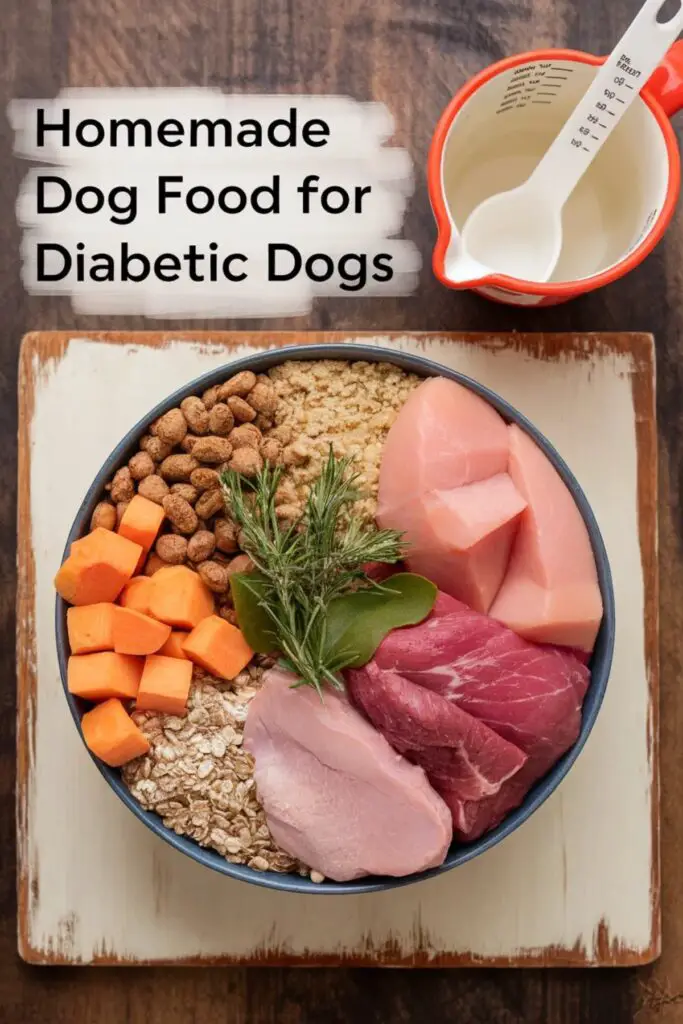
When preparing homemade dog food for diabetic dogs, it’s important to choose ingredients that help regulate blood sugar levels while still providing all the essential nutrients your dog needs. These ingredients should be low in simple sugars and refined carbs, while offering a balance of healthy fats, proteins, and fiber. Here are the key components to consider when creating meals for diabetic dogs:
High-Quality Protein Sources
Protein is an essential part of a dog’s diet, and it plays an important role in maintaining muscle mass and overall health. For diabetic dogs, protein helps slow down the absorption of carbohydrates, which aids in preventing blood sugar spikes.
- Examples of high-quality protein sources:
- Chicken breast: Lean and easily digestible, chicken is an excellent source of protein that’s low in fat.
- Turkey: Another lean protein that’s low in fat, making it a great choice for diabetic dogs.
- Lean beef: A good source of protein, though it’s higher in fat than chicken or turkey, so it should be used in moderation.
- Fish (such as salmon or sardines): Rich in omega-3 fatty acids, which are great for your dog’s skin, coat, and overall health.
- Eggs: A highly digestible protein source, eggs are also rich in vitamins and minerals.
Low Glycemic Carbohydrates
Carbohydrates are a key consideration in a diabetic dog’s diet. To manage blood sugar levels, you need to select carbohydrates that release glucose slowly into the bloodstream. Foods with a low glycemic index (GI) help keep blood sugar levels stable and prevent spikes.
- Examples of low glycemic carbohydrates:
- Sweet potatoes: Rich in fiber and antioxidants, sweet potatoes are a healthy carb choice that helps regulate blood sugar.
- Quinoa: A low-glycemic, high-protein whole grain that’s a great source of complex carbs.
- Brown rice: A whole grain that provides slow-releasing energy and is easier to digest than white rice.
- Oats: Another whole grain that’s full of fiber and helps regulate blood sugar.
- Barley: High in soluble fiber, which can help manage blood sugar levels and promote digestive health.
Healthy Fats for Diabetic Dogs
Fats are a vital source of energy for dogs, but they must be the right kind. Healthy fats from quality sources help support your dog’s immune system, brain function, and skin health, while also providing a steady energy supply.
- Examples of healthy fat sources:
- Fish oil: Rich in omega-3 fatty acids, which are beneficial for heart health, inflammation reduction, and joint health.
- Flaxseed: Contains omega-3s and fiber, which help regulate blood sugar and support healthy skin and coat.
- Olive oil: A great source of monounsaturated fats, which support heart health and provide essential antioxidants.
- Coconut oil: Contains medium-chain triglycerides (MCTs), which are easily digestible and provide quick energy.
Fiber-Rich Vegetables
Fiber helps stabilize blood sugar levels by slowing the absorption of glucose in the intestines. It also aids in digestion and helps prevent constipation. Vegetables should be a significant part of your diabetic dog’s diet, but make sure to choose high-fiber options that are low in sugar.
- Examples of fiber-rich vegetables:
- Green beans: Low in calories and high in fiber, green beans are a great low-glycemic vegetable.
- Carrots: Rich in fiber and vitamins, carrots are a healthy option for diabetic dogs in moderation.
- Spinach: Packed with nutrients and fiber, spinach is an excellent vegetable choice for diabetic dogs.
- Pumpkin: High in fiber and low in sugar, pumpkin helps regulate blood sugar and supports digestive health.
- Broccoli: A low-calorie, fiber-rich vegetable full of vitamins and minerals that support overall health.
Essential Supplements
Although a balanced homemade diet should provide most of the essential nutrients, certain supplements can help fill in any nutritional gaps. For diabetic dogs, these supplements can support their overall health and well-being.
- Examples of essential supplements:
- Omega-3 fatty acids: Fish oil or flaxseed oil is a great source of omega-3s, which can help reduce inflammation and support heart and joint health.
- Probiotics: These beneficial bacteria help support digestion and immune health, especially since diabetic dogs are at higher risk of gastrointestinal issues.
- Vitamins A and E: These vitamins are important for immune function, skin health, and overall vitality.
- Magnesium: Helps maintain normal blood sugar levels and supports muscle and nerve function.
- Zinc: Supports the immune system and helps in wound healing, which is important for diabetic dogs who may have skin issues due to high blood sugar
Foods to Avoid in Homemade Dog Food for Diabetic Dogs
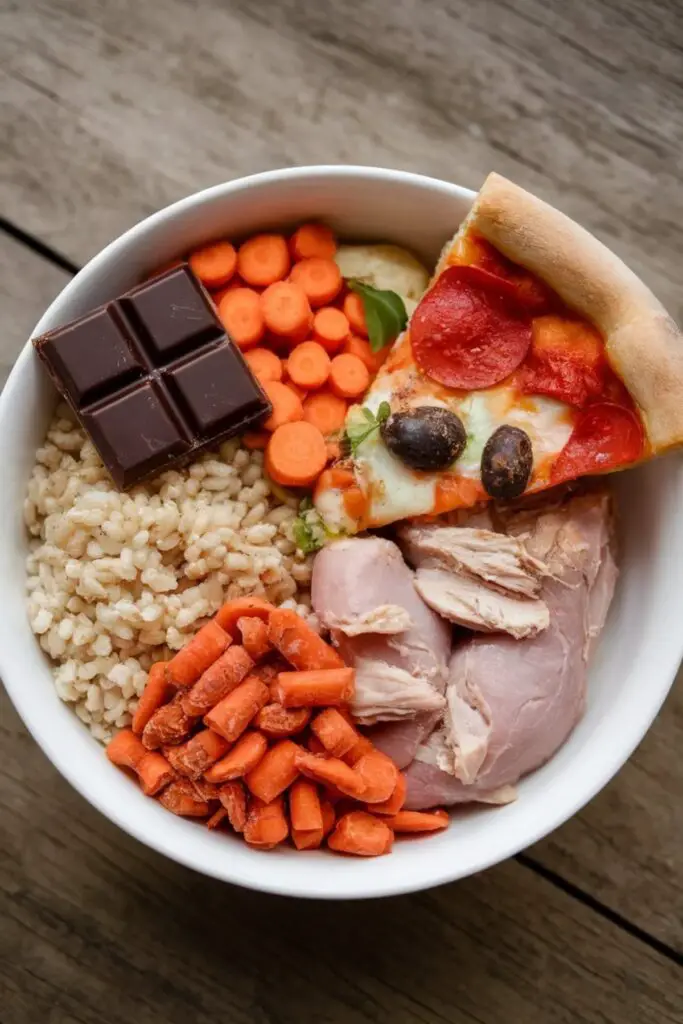
When preparing homemade dog food for diabetic dogs, it’s just as important to avoid certain ingredients that can negatively impact their blood sugar levels or overall health. Some foods are high in simple sugars, unhealthy fats, or other substances that can cause blood sugar spikes or contribute to insulin resistance. Below are some common foods and ingredients to steer clear of when preparing meals for a diabetic dog:
1. Simple Carbohydrates and Sugary Foods
Foods that are high in simple sugars or refined carbohydrates can cause rapid spikes in blood sugar levels, making it harder to manage your dog’s diabetes. These types of carbs are quickly broken down into glucose, leading to high blood sugar.
- Examples to avoid:
- White rice: It has a high glycemic index, meaning it can cause a quick spike in blood sugar.
- White bread: Highly refined and processed, white bread contains little fiber and causes a rapid increase in blood glucose.
- Pasta: Like bread and white rice, pasta is made from refined grains that can cause blood sugar levels to spike.
- Sugary fruits (e.g., grapes, raisins, or bananas): While fruits are generally healthy, some contain high amounts of sugar that can affect blood sugar levels.
2. High-Fat Meats
While some fat is essential for a diabetic dog’s diet, excessive fat can contribute to insulin resistance, especially in dogs that are overweight. Avoid fatty cuts of meat that may provide too many unhealthy fats and excess calories.
- Examples to avoid:
- Fatty cuts of beef or pork: These meats are high in saturated fats that can lead to weight gain and negatively affect insulin sensitivity.
- Processed meats (e.g., bacon, sausage): Processed meats often contain added sugars, preservatives, and unhealthy fats, making them unsuitable for diabetic dogs.
3. High-Sugar Vegetables and Starchy Foods
While vegetables are a great source of vitamins, minerals, and fiber, some vegetables are high in starch or sugar, which can spike blood sugar levels in diabetic dogs. Starchy vegetables, while they provide energy, can have a high glycemic index and should be limited.
- Examples to avoid:
- Corn: Often used as a filler in commercial dog food, corn is a high-glycemic ingredient that can raise blood sugar levels.
- Peas: While not inherently bad, peas are higher in carbohydrates and should be used sparingly.
- Potatoes: Regular potatoes (especially white potatoes) are high in starch and have a high glycemic index. If you use potatoes, choose sweet potatoes, which have a lower glycemic index and are better for diabetic dogs.
4. Artificial Sweeteners
Some artificial sweeteners, like xylitol, are extremely toxic to dogs and should never be included in homemade dog food. Even in small quantities, xylitol can cause rapid insulin release, leading to life-threatening low blood sugar levels (hypoglycemia), liver failure, and seizures.
- Other sweeteners to avoid:
- Aspartame
- Saccharin
5. Dairy Products
Dairy products like milk, cheese, and yogurt contain lactose, a sugar that can be difficult for some dogs to digest, especially those that are lactose intolerant. While a small amount of cheese or yogurt might be acceptable for some dogs, it’s generally best to avoid dairy or limit it in a diabetic dog’s diet.
6. Spices and Seasonings
Certain spices and seasonings can upset a diabetic dog’s stomach, cause digestive issues, or even be toxic in large quantities. When preparing homemade dog food, avoid adding salt, garlic, onions, or any other spices that may be harmful.
- Examples to avoid:
- Onions and garlic: Both onions and garlic are toxic to dogs and can cause damage to red blood cells, leading to anemia.
- Salt: Excessive salt can contribute to high blood pressure and kidney problems, which is especially dangerous for diabetic dogs.
7. High-Calcium Foods
Excess calcium can interfere with the absorption of other important nutrients, such as magnesium and phosphorus. High-calcium foods like certain dairy products or bone meal should be avoided or used sparingly in a diabetic dog’s diet.


Hi, I’m Ali Tarek, the founder of Animalsman. I’ve always been passionate about pets, especially dogs and cats, and I created this website to share practical tips, easy recipes, and helpful care advice for fellow pet lovers. My goal is to make pet care simple, enjoyable, and accessible for everyone. When I’m not writing or curating content, you’ll usually find me spending time with my furry friends or learning new ways to keep them happy and healthy.



